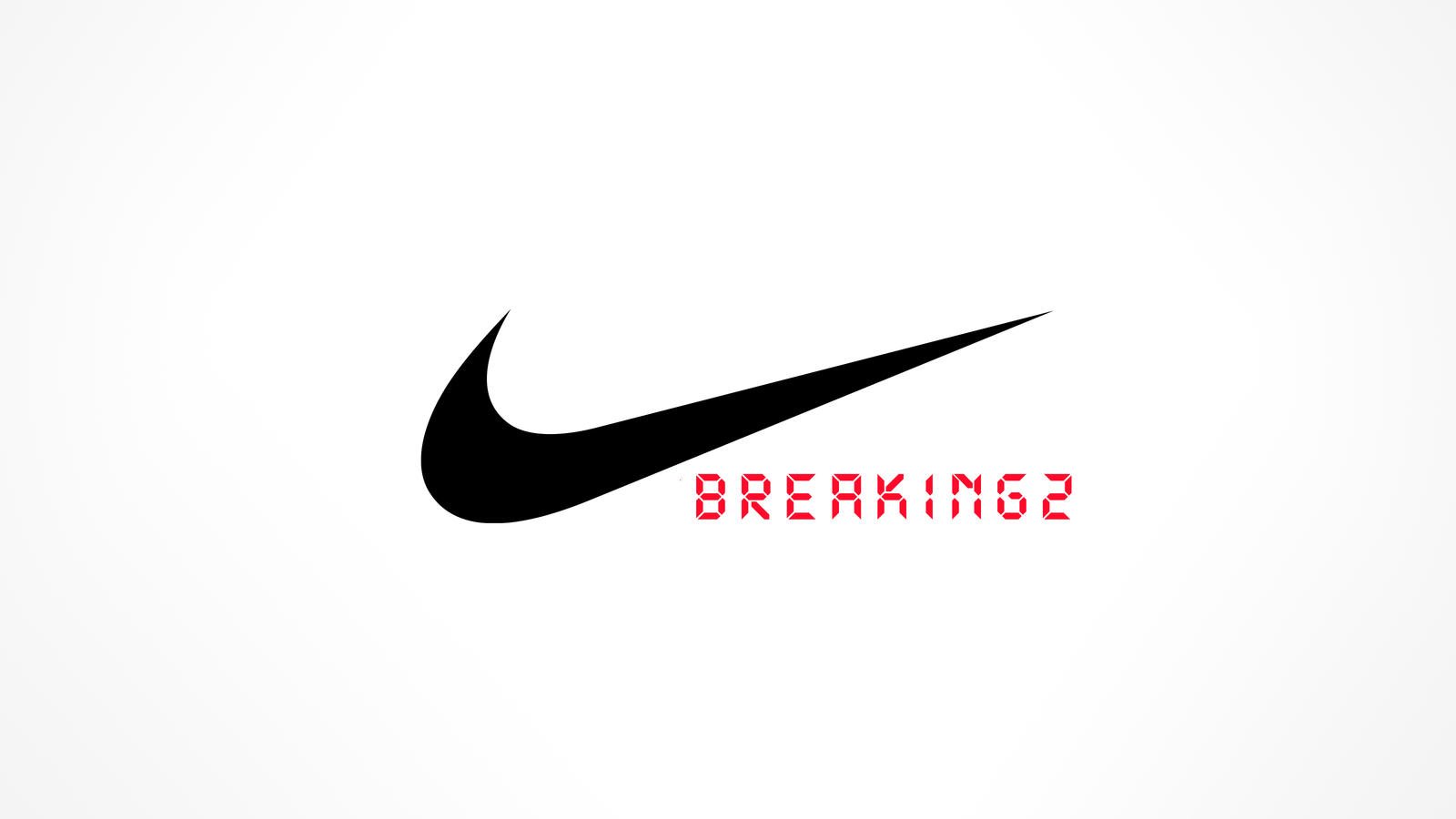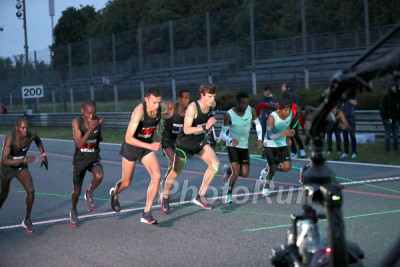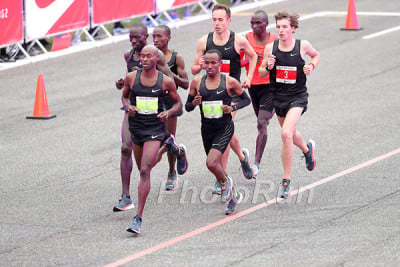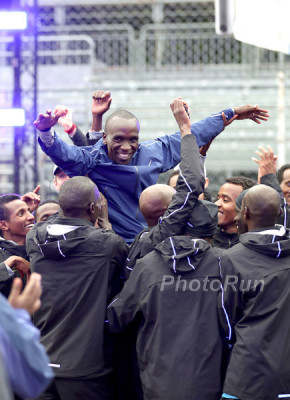Pacing2: Chris Derrick & Andrew Bumbalough Tell What It Was Like to Pace Eliud Kipchoge to 2:00:25
By Jonathan Gault
May 9, 2017
Last week, Kenya’s Eliud Kipchoge ran 2:00:25 for 26.2 miles at the Autodromo Nazionale Monza, a Formula One track in Italy, as part of Nike’s much-ballyhooed attempt to run under 2:00 in the marathon, Breaking2. Though Kipchoge and fellow marathoners Lelisa Desisa and Zersenay Tadese were the only ones actually trying to run 26.2 miles, dozens of Nike staffers assisted in the attempt, including a fleet of 18 pacers for the lead group, all of whom were accomplished Nike athletes in their own right. I caught up with two of them, Americans Chris Derrick and Andrew Bumbalough of the Bowerman Track Club, who shared what it was like to be part of the attempt.
Breaking2 pacer recruitment began in mid-March, when Derrick, 26, and Bumbalough, 30, were both contacted by Nike sports marketing to see if they were interested in taking part in the attempt. Both men were excited by the idea and accepted immediately. Nike also threw some money their way to make it worth their while.
“I knew a lot of people who had been involved in the project at various levels at Nike and I knew it was a big initiative for the company,” Derrick said. “I already had my World Championship standards out of the way so I thought it would be a pretty cool thing to be a part of.”
Only one hurdle remained: securing the permission of Bowerman TC coach Jerry Schumacher, who can be notoriously picky when selecting his athletes’ racing opportunities. Though the travel involved wasn’t ideal — it’s 5,500 miles from Portland to Monza, as the crow flies — Schumacher was excited for Bowerman TC to be part of the attempt. The event fit into the schedules of Derrick, Bumbalough and Lopez Lomong, and all three took Nike up on its offer.
The pacers arrived in Italy on the Sunday prior to the attempt, where they were put up in the tony Hotel de la Ville in Monza. In addition to the Bowerman men, the pacers included Americans Bernard Lagat and Sam Chelanga and 2016 Olympians Nguse Tesfaldet (Eritrea), Aron Kifle (Eritrea) and Stephen Mokoka (South Africa). The next five days served as pacer boot camp. On Monday, the runners were briefed on the specifics of the project. They were divided into six groups of three, with each group assigned a letter and color for identification. The goal was to ensure that athletes who spoke the same language were grouped together. Derrick and Bumbalough were placed in Group A (red), along with Chelanga.
Each group was also assigned a captain — for Group A, it was Derrick. The pacers were informed that they would be running in a triangle formation, one group occupying the three-man back row, with another group taking the front three spots. Though the captain needed to be able to speak decent English, his most important role was keeping the group together and on pace. He would run in the middle when it was his group’s turn to run at the back. When it was his group’s turn to set the pace up front, the captain would serve as point man, forming the top of the triangle.
The next two days were each dedicated to a specific aspect of pacing, with the group spending Tuesday working on running in the triangle formation and Wednesday practicing “exchanges,” where one group would sub in for another (each group ran two 2,400-meter laps at a time). On Thursday, the pacers did a dry run of the attempt (though they didn’t go the full 26.2 miles), with three runners playing the role of the Kipchoge, Desisa and Tadese, aka the “primaries.”
Though these sessions took place early in the morning, with the pacers usually leaving the hotel at 5 a.m. each day, that didn’t prove much of a problem for the men of Bowerman TC.
“Coming from Portland (9 hours behind Monza), my body didn’t know what time it was anyway, so I just went to bed at 8:00 every night,” Derrick said.
None of the morning sessions were taxing on the runners’ bodies, with no more than 30 minutes of total running, very little of it at actual 2:00:00 marathon pace. Derrick and Bumbalough said that they were able to train pretty much as usual during the week. The hotel abutted a large park with an extensive trail system, of which the athletes took full advantage.
“A couple days, Chris and I actually ended up running three times,” Bumbalough said. “It was almost like Kenyan tripling, where they go 6:00 a.m., 10:00 a.m. and another 5:00 or 6:00 p.m. run.”
Nike also understood that each of the pacers had their own season to prepare for and made arrangements for the athletes to use local tracks. On Wednesday, the company set up a shuttle to the track for the Bowerman men. Their driver? Vénuste Niyongabo, the 1996 Olympic 5,000-meter champion from Burundi, who works in Italy for Nike.
“That was pretty cool to be chauffeured by an Olympic champion,” Derrick said.
***
Making Friends and Geeking Out
Though the primary goal of pacer boot camp was to ensure everything ran smoothly for the attempt on Saturday, all the time spent working together produced a nice side benefit as athletes who would normally face each other as competitors came from around the world to unite for a common goal.
“That was one of the best parts, just getting to develop a team vibe with all those guys you normally wouldn’t be in that situation with,” Derrick said. “It was a great time. I think we all got invested over the course of the week into the project. I think we probably understood, about as well as anybody, how hard it was, what he was doing. Because some of those guys have run very fast marathons themselves. But also we all ran the pace and it didn’t exactly feel easy.”
Bumbalough said the team atmosphere reminded him of his college running days.
“Normally when you go to a Diamond League, let’s say, you have your group that you know, that you’re used to, whether it’s a training partner or someone you know fairly well from your own country that you’ve seen a bunch at different races or whatever. And there’s this nervous energy where you can’t quite let your guard down as much, maybe, because you’re so focused on a race that’s coming up. Whereas this event, it felt [different], like being on a team….It’s rare, I feel like, that at this level, you have this sort of opportunity where you’re seeking out new people to have dinner with each night and really trying to get to know everyone.”
One other element of boot camp left a lasting impression on both men: Eliud Kipchoge himself.
“When I first heard about it, I thought, okay, two hours, that seems insane,” Bumbalough said. “That sounds outlandish, ridiculous.”
But after arriving in Italy and spending time with Kipchoge, both Derrick and Bumbalough reached the same conclusion: Maybe he can actually do this thing. It was more than the Olympic champion’s words that won them over; it was the way he carried himself: calm, confident, and purposeful at all times.
“At that point, from everything I’ve seen, viewing the sport and watching Kipchoge run and just talking to everyone around him, I’ve basically come to believe that he was capable of anything,” Derrick said. “Nothing he could do, it might surprise me, but it couldn’t shock me. He just has a certain aura about him, a certain confidence that he can do things that shouldn’t be able to be done.”
“It’s this crazy mix of calm and belief,” Bumbalough said. “It’s not arrogant. It’s not cocky…It’s kind of the most extreme version of self-belief paired with just this absolute calm and composure. It’s pretty wild. There haven’t been that many athletes that I’ve felt that around…Basically, it made me want to package up a little bit of it and try to emulate it as best I can.”
Indeed, after the attempt was over, Bumbalough and the rest of the pacers went up to Kipchoge and for a moment, they were transformed into fans just like the rest of us. Everyone wanted a picture with the great man. Bumbalough asked him to sign his jersey. It was the first time he’d asked a fellow runner for an autograph since Alan Webb, back when Bumbalough was in high school.
***
The Attempt
The day of the attempt, Saturday, began early for the pacers. With a start time of 5:45 a.m., their wakeup call at the hotel came at 3:00 a.m. And even though their role in the attempt was small, it was important.
“Definitely, I was a little nervous,” Derrick said. “Not like race-day nervous. I was more excited than anxious.”
“Setting a pace that fast and trying to do it for that long, the margins are super, super fine,” Bumbalough said. “I was nervous because I wanted to do a good job and didn’t want anything to go wrong or be a part of anything that went wrong with it. That said, I was pretty excited too.”
The pacers were driven to the track, where a light fog lifted off the ground in the pre-dawn darkness. Nike had set up several neon lights around the finish area. As they drove toward it, Bumbalough thought it looked as if a UFO had landed in the middle of the park.
Before the attempt, the pacers were given their final instructions. They were told to stay six meters behind the lead vehicle, a Tesla Model S, and to keep their triangle formation tight and inside the pace car’s laser projection. Though it sounds easy, like any simple task, it becomes more difficult if you overthink it.
“I kind of compare it to when someone’s doing an MRI or something and they say ‘don’t move,'” Derrick said. “That’s easy. But then once you think about it, it’s really hard. You get really nervous, shaky or whatever. That’s kind of the way I felt.”
Above all, they were told to remain calm and run smooth — the last thing Nike wanted was a disruption that would break the concentration of Kipchoge, Desisa or Tadese.
Though the lead vehicle was equipped with a pace clock, it wound up malfunctioning partway through the attempt. Both Derrick and Bumbalough said that the malfunction didn’t make much of a difference. Neither of them used a GPS watch, either (Derrick didn’t wear one, and Bumbalough didn’t start his). Instead, the pacers relied mostly on feel and feedback from Valentijn Trouw (one of Kipchoge’s agents) and Brett Kirby, the lead physiologist at the Nike Sport Research Lab, who biked alongside the runners. The course had timing mats laid out every 200 meters, and Trouw and Kirby would let the runners know if they needed to adjust their pace.
“We were given instructions to follow the car and we knew that the car was going to be fairly accurate but at the end of the day, I think really tuned-in athletes can kind of sense pace,” Bumbalough said. “With the car, there were different points at the ‘S’ curve, the chicane, [where] the car couldn’t take the most direct route through the chicane, it couldn’t take the tangent as well [as we could]. So if you just turned your brain off and followed the laser, you wouldn’t actually be maintaining the exact pace.”
Everything went mostly according to plan, though there was one hiccup. Around 35 minutes into the attempt, one of the pacers in the group ahead began to labor and was struggling to stay in formation. It was Derrick’s job, as a captain, to deal with it. He gently ushered him off the course, allowing the attempt to proceed smoothly (you can watch the incident here).
Group A ran 4.58 laps (the first lap was abbreviated so that the total distance equaled 26 miles, 385 yards), totaling 10,992 meters in all at approximately 4:34 mile pace (neither man received exact splits for their group). They had approximately 27 minutes between segments. After completing a segment, Derrick and Bumbalough spent the first five minutes walking or slowly jogging before launching into an extended warmup run for 8-10 minutes. Then they ran four hard strides and prepared to jump back in for their next segment. Once their official duties had concluded, they were asked to pace Desisa (who had fallen off the pace) for a lap, which they did.
Both men said their effort felt like a medium-intensity workout. They also noted that while the extended rest aided with recovery, there was a drawback in that it was harder to stay warmed up and in the same rhythm as a traditional workout.
After they finished pacing Desisa, Group A returned to the pacer tent about 200 meters from the finish line, where the rest of the pace groups not involved in the final segment watched the finish. Out of respect, they were told to stay in the pace tent until Desisa, the last runner, crossed the finish line. One interesting note: the pacers had access to a ton of information while they were in the tent. Unfortunately, almost none of it made it into the race broadcast.
“In the pacer tent, there was constant data on a television screen being shot out essentially,” Bumbalough said. “All the splits and then the projected finish time and all that…There was a lot of data available when you were in the tent.”
Once the attempt was over, the pacers had time for some fun. In the immediate aftermath of the attempt, the Ethiopians led the group in singing and chanting as they approached the finish line to celebrate Kipchoge, while the Kenyans lifted their countryman onto their shoulders. That night, there was a party at the hotel, with Kipchoge hopping on the DJ kit. On Sunday, a large contingent of Nike employees, including Derrick and Bumbalough, went to the AC Milan-Roma soccer match in Milan. And while those memories were great, what the Bowerman men will remember most is the brilliance of Kipchoge.
“How we felt running versus how he looked was certainly a humbling experience,” Derrick said. “I was very, very honored and happy to be a part of it and I’m glad I went.”
“Chris and I were discussing if we ran a 60:00 half marathon, we would both be pretty happy with that,” Bumbalough said. “The fact that he’s essentially doing two back-to-back and really only faltering at all in the last 5k or so is pretty stupendous…What he did was mind-blowing. It was crazy. It’s amazing. Just running the pace and knowing he’s doing that for two hours, it’s just one of those jaw-dropping moments.”
Discuss this article here in our forums.






